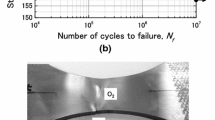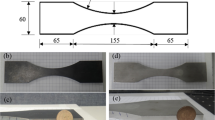Abstract
Using electromagnetic acoustic resonance (EMAR), we studied the evolution of the surface shearwave attenuation and phase velocity in a 0.45 pct C steel and a 5052 aluminum alloy exposed to rotating bending fatigue. In the EMAR method, we used electromagnetic acoustic transducers (EMATs) for the contactless measurements of the axial shear wave, which is a surface shear wave that propagates along a cylindrical surface in the circumferential direction, with an axial polarization. There has been no previous report of continuous and contactless monitoring of the surface wave attenuation and velocity being performed without interrupting the fatigue. The attenuation coefficient always showed sharp peaks around 90 pct of the fatigue life, independent of the fatigue-stress amplitude. To interpret this phenomenon, we made crack-growth observations using replicas and measurements of recovery of attenuation and velocity by stopping the cyclic loading before and after the peak. From these results, we concluded that the evolution of the ultrasonic properties is caused by a drastic change in dislocation mobility being accompanied by the crack growth at the final stage of the fatigue life.
Similar content being viewed by others
References
H. Schenck, E. Schmidtmann, and H. Kettler: Arch. Eisenhuettenw., 1960, vol. 31, pp. 659–69.
W.J. Bratina and D. Mills: Can. Metall. Q., 1962, vol. 1, pp. 83–97.
D. Mills and W. Bratina: Proc. Symp. on Physics and Nondestructive Testing, San Antonio, TX, 1963, Southwest Research Institute, pp. 356–71.
Z. Pawlowski: Proc. 4th Int. Conf. on Nondestructive Testing, Butterworth and Co., London, 1964, pp. 192–95.
V.S. Ivanova: The Role of Dislocations in the Strengthening and Failure of Metals, National Lending Library for Science and Technology, 1967.
W.J. Bratina: in Physical Acoustics IIIA, W.P. Mason, ed., Academic Press, New York, NY, 1966, pp. 268–91.
R. Truell and A. Hikata: Fatigue and Ultrasonic Attenuation, ASTM-STP 213, ASTM, Philadelphia, PA, 1957, pp. 63–70.
S. Golovin and A. Puskar: Mater. Sci. Forum, 1993, vols. 119–121, pp. 407–12.
G. Fei and Z. Zhu: Phys. Status Solidi (a), 1993, vol. 140, pp. 119–26.
Z. Zhu and G. Fei: J. Alloys Compounds, 1994, vols. 211–212, pp. 93–95.
H. Ogi, M. Hirao, and K. Minoura: J. Appl. Phys., 1997, vol. 81, pp. 3677–84.
M. Hirao, H. Ogi, and H. Fukuoka: Rev. Sci. Instrum., 1993, vol. 64, pp. 3198–3205.
M. Hirao and H. Ogi: Ultrasonics, 1997, vol. 35, pp. 413–21.
H. Ogi, K. Minoura, and M. Hirao: in Review of Progress in QNDE, D.O. Thompson and D.E. Chimenti, eds., Plenum Press, New York, NY, 1996, pp. 1939–44.
W.L. Johnson, B.A. Auld, and G.A. Alers: in Review of Progress in QNDE, D.O. Thompson and D.E. Chimenti, eds., Plenum Press, New York, NY, 1994, pp. 1603–09.
G.L. Petersen, C.M. Fortunko, B.B. Chick, and M. Hirao: Rev. Sci. Instrum., 1994, vol. 65, pp. 192–99.
H. Ogi, M. Hirao, and T. Honda: J. Acoust. Soc. Am., 1995, vol. 98, pp. 458–64.
A.S. Nowick and B.S. Berry: Anelastic Relaxation in Crystalline Solids, Academic Press, New York, NY, 1967.
A. Granato and K. Lucke: J. Appl. Phys., 1956, vol. 27, pp. 583–93.
M. Klesnil and P. Lukas: Fatigue of Metallic Materials, Elsevier, New York, NY, 1980.
A.H. Cottrell and B.A. Bilby: Proc. Phys. Soc., 1949, vol. A62, pp. 49–62.
A. Granato, A. Hikata, and K. Lucke: Acta Metall., 1958, vol. 6, pp. 470–80.
W.J. Bratina: in Physical Acoustics IIIA, W.P. Mason, ed., Academic Press, New York, NY, 1966, p. 278.
H. Ogi, A. Tsujimoto, M. Hirao, and H. Ledbetter: Acta Mater., 1999, vol. 47, pp. 3745–51.
Author information
Authors and Affiliations
Rights and permissions
About this article
Cite this article
Ogi, H., Hamaguchi, T. & Hirao, M. Ultrasonic attenuation peak in steel and aluminum alloy during rotating bending fatigue. Metall Mater Trans A 31, 1121–1128 (2000). https://doi.org/10.1007/s11661-000-0107-1
Received:
Issue Date:
DOI: https://doi.org/10.1007/s11661-000-0107-1




